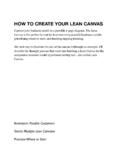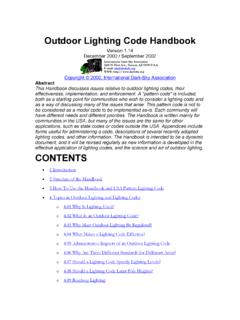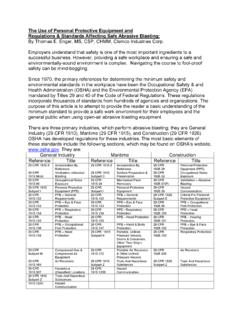Transcription of HOW TO CREATE YOUR LEAN CANVAS
1 HOW TO CREATE YOUR lean CANVASC apture your business model in a portable 1-page diagram. The lean CANVAS is the perfect format for brainstorming possible business models, prioritizing where to start, and tracking ongoing best way to illustrate the use of the CANVAS is through an example. I ll describe the thought process that went into building a lean CANVAS for the companion business model hypotheses testing tool - also called lean CANVAS . Brainstorm Possible CustomersSketch Multiple lean CanvasesPrioritize Where to StartBrainstorm Possible CustomersYou most likely already have an inkling of the problem, solution, and customer in mind. Start by brainstorming the list of possible customers you envision using your product.
2 1. Distinguish between customers and usersIf you have multiple user roles in your product, identify customers. A customer is a someone that pays for your product. broad customer segments into smaller onesI ve worked with startups that felt the problems they are solving are so universal, they apply to everyone. You can t effectively build, design, and position a product for everyone. While you might be aiming to build a mainstream product, you need to start with a specific customer in mind. Even Facebook, with it s now 500 million+ users started with a specific user in mind - Harvard college students. 3. Sketch a lean CANVAS for each customer segmentAs you ll find shortly, the elements of your business model can and will vary greatly by customer segment.
3 I recommend starting with the top 2-3 customer segments you feel you understand the best or find most promising. 2 HOW TO CREATE YOUR lean CANVASCase-study: lean CanvasBackgroundIn the course of applying Customer Development and lean Startup principles to my products, I inevitably needed to document my business model hypotheses. I started with the worksheets at the end of Steve Blank s book: The Four Steps to the Epiphany . While this was a great exercise, the output was a collection of documents and spreadsheets that become hard to manage and share with other team members over time. I then ran into Alex Osterwalder s work on Business Model CANVAS . While I really liked the portability and clarity of a 1-page business model, I found some of his CANVAS elements too general and started toying with an adaptation that eventually became the lean CANVAS .
4 The scope of the problems I was addressing also grew from just documenting hypotheses, to measuring and communicating progress over I started, I envisioned the lean CANVAS being a replacement for worksheets and business plans which led to the following possible customers brainstorm list:Really broad category: Anyone that uses a business plan todayMore Specific Possible Customers:1. Startup founders (bootstrapped, funded)2. Startup accelerators3. Investors (Angels, VC)4. Large companiesSince this was a scratch my own itch kind of problem, I decided to build my first lean CANVAS for startup founders. RUNNING lean 3 Sketch Multiple lean CanvasesIn this section, I ll outline the process for sketching a lean CANVAS .
5 1. Sketch a CANVAS in one sittingWhile a business plan can take weeks or months to write, your initial CANVAS should be sketched quickly. 2. It s okay to leave sections blankRather than trying to research or debate the right answers, put something down quickly or leave it blank and come back to it later. Some elements like Unfair Advantage take time to figure out. The CANVAS is meant to be an organic document that evolves over time and it s okay to say I don t know .3. Think in the presentBusiness plans try too hard to predict the future which is impossible. Instead, write your CANVAS with a getting things done attitude. Based on your current stage and what you know right now, what are the next set of hypotheses you need to test to move your product forward?
6 4. Use a customer-centric approachWhile Alex Osterwalder discusses several alternative approaches to sketching an initial CANVAS in his book, I prefer using a customer-centric approach. I start with the Customer Segment and follow a prescribed order to filling out a CANVAS : 4 HOW TO CREATE YOUR lean CANVASRUNNING lean 5 Problem and Customer SegmentsI find that the Problem-Customer pair usually drives the rest of the CANVAS which is why I tackle them together: 1. List top 3 problemsFor the customer segment you are working with, describe the top 1-3 problems they need solved. 2. List existing alternativesThen document how you think your early adopters address these problems today. Unless you are solving a brand new problem (unlikely), most problems have existing solutions.
7 Many times these may not be a readily obvious competitor. As an example, the biggest alternative to most online collaboration tools is not another collaboration tool, but email. Doing nothing could also be a viable alternative for a customer if the pain is not acute Identify other user rolesNext identify any other user roles that will interact with this a blogging platform, the customer is the blog author while the user is a reader. 2. In a photo sharing service, the customer is the sharer, while users are viewers (family and friends).6 HOW TO CREATE YOUR lean CANVAS4. Hone in on possible early adoptersWith these problems in mind, get more specific on the customer segment. Narrow down the distinguishing characteristics of your prototypical customer.
8 Your objective is to define an early adopter - not a mainstream an example, my last product, CloudFire, was a photo and video sharing service targeted at parents. Further refinement got me to define my early adopters as first-time moms with kids under the age of three . Case Study: lean CANVAS - Problem and Customer SegmentsCustomer Segment: Startup Founder1. Top 3 problemsProblem 1: Business Models need to be more portableBusiness Plans are too static and don t get read or updated enough. A lot of entrepreneurs skip this step altogether which is NOT the solution. Problem 2: Measuring progress is hard workCustomer Discovery is a qualitative process and requires a lot of work (documenting interviews, aggregating results, etc.)
9 To yield actionable 3: Communicating learning is critical The biggest mind shift when practicing a lean Startup methodology is being objective and instilling a culture of continuous learning and improvement by holding ourselves accountable to internal and external lean 72. Existing AlternativesIntuition, business plans, User RolesCreators (Startup Founders): Responsible for documenting hypotheses and communicating progress. Collaborators (Advisors/Investors) :Help the founders by providing advice and holding them Early AdopterSince the lean CANVAS was a product of synthesizing Customer Development, lean Startups, and the Business Model CANVAS , I believe an early adopter would be someone who has had some familiarity with at least one and ideally all of the HOW TO CREATE YOUR lean CANVASRUNNING lean 9 Unique Value Proposition Dead-center in the lean CANVAS is a box for your Unique Value Proposition (UVP).
10 This is one of the most important boxes on the CANVAS and also the hardest to get right. Unique Value Proposition: A single, clear compelling message that states why you are different and worth buying. - Steve Blank The Four Steps to the EpiphanyThe UVP is hard to get right because you have to distill the essence of your product in a few words that can fit in the headline of your landing page. Additionally, your UVP also needs to be different and that difference needs to visitors spend 8 seconds on average on a landing page. Your UVP is their first interaction with your product - craft a good UVP and they might stay and view the rest of your site. Otherwise, they ll simply good news is you don t have to get this perfect right away.







